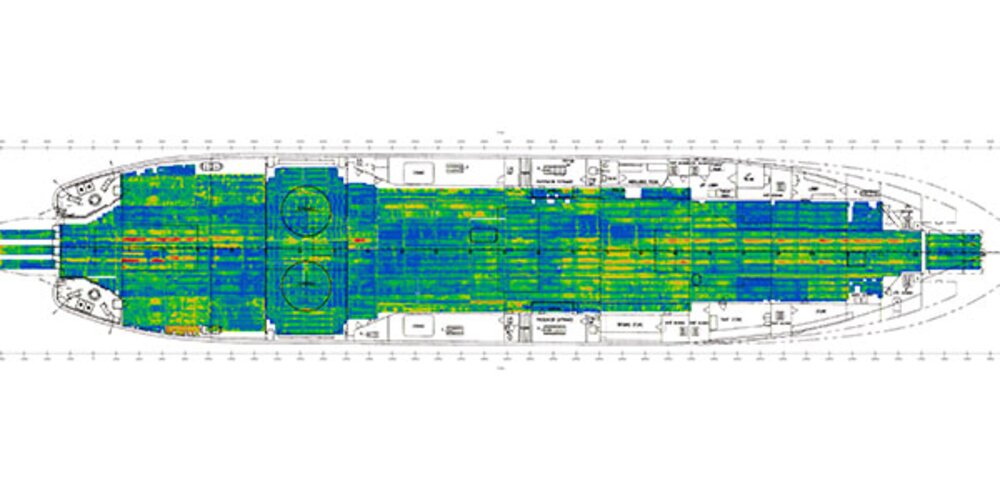Browse our services
Explore how Brookes Bell can help you
Find an expert
Meet our team, find and expert and connect
Contact us
Get in touch, we're here to help

Non-destructive testing encompasses a range of testing and analysis techniques used to evaluate the properties of a material, component, structure or system for corrosion, defects or discontinuities without damaging the original part.
Brookes Bell has a dedicated team of NDT technicians and inspection engineers who work with clients around the world to evaluate material quality and performance on a range of assets, equipment or plant.
Arron Jackaman, senior inspection engineer and ISO 9712/17024 Level 3 Non-Destructive Engineer explains that new cutting-edge NDT techniques are revolutionary, because for the very first time, it’s possible to get a full picture of the asset, facility or plant being investigated.
Using advanced NDT techniques, for instance using Pulsed Eddy Current Array (PECA) the engineer can see the condition of the material under inspection in its entirety, even through thick lagging and coatings whereas previously these barrier materials would have to be physically removed to inspect the material. One example is corrosion monitoring and evaluation on ships steel, historically the classification societies check a small area, say less than 5%, and then take an average value and scale it up to estimate actual condition of the total area of material. With the NDT method of PECA scanning we can visualise and assess nearly 100% of accessible locations.
NDT is an extremely valuable technique that can save both money and time in product evaluation, troubleshooting, and research. Brookes Bell’s technicians and inspection engineers use state-of-the-art inspection equipment supported by the new laboratory services and apply advanced analytical solutions to examine and assess client assets.
Some of our common applications for NDT are to examine welding, or heat exchanger and condenser tube bundles, or cargo tank, pressure vessel and tanktainer corrosion.
In the case of welding, Brookes Bell uses advanced Eddy current array (ECA) techniques to examine welding for any harmful defects such as such as surface breaking cracks in ferromagnetic and non-ferromagnetic weld materials. ECA can be carried out in dirty, coated and abrasive surface conditions and on all sorts of weld shapes (the probes simply adapt to fit the weld crown).
ECA is a natural extension of Eddy Current Testing (ECT) that uses a multiplexed arrays of coils arranged in rows. It can cover large areas much faster and with greater sensitivity than conventional ECT, using single scan passing to detect surface-breaking cracks as small as 0.5mm and sub-surface defects to a penetration depth of 6mm or more.
NDT is also used for life cycle monitoring by way of electromagnetic testing, inspection and analysis to examine heat exchangers and condenser tube bundles. Ferrous tubes are commonly used in the shell and tube heat exchangers of the oil, gas, petrochemical industry. Brookes Bell applies NDT techniques to detect and mitigate corrosion, pitting, cracking and erosion in the tube bundles, including aluminium-finned carbon steel air cooler tubes.
Non-ferrous metals, like inconel, cupronickel and stainless steel are used to make tube bundles for the marine, power generation and nuclear industries because they are resistant to corrosion and stress cracking in systems such as HVAC Chillers and in nuclear Steam Generators. Here the eddy current arrays are used to inspect these tubes because they are perfectly suited to non-ferrous alloys.
Brookes Bell’s non-destructive evaluation (NDE) process uses Magnifi, the most advanced data acquisition and analysis software in the heat transfer industry, to evaluate the resulting electromagnetic inspection data. While TubePro reporting software allows Brookes Bell’s engineers to build accurate digital twins of heat exchanger tube bundles, optimising efficiency and allowing for a full trend analysis to be performed.
Brookes Bell also uses NDT to examine cargo tanks, pressure vessels and tanktainers, developing corrosion mapping solutions and surface inspection methods for both ferrous and non-ferrous tanks which can be used in off hire surveys and aggressive cargo disputes.
Using a range of techniques; Eddy Current Array Corrosion Mapping (ECA, SPYNE, I-Flex, PECA), Automated and Semi-automated Ultrasonic Corrosion Mapping (RMS UT, PAUT), Visual Testing (Portable Stereomicroscopy), Field Metallurgical Replication (FMR) and Corrosion Under Insulation (CUI), Brookes Bell can provide a full corrosion assessment and steel renewal estimation of deck and shell plating under thick coatings such as composite cladding, Teak or Bolidt deck.
Accurate corrosion mapping (CMAP) models can be generated for ships approaching drydock refit, intermediate or special Class survey. The process enables streamlining of schedules allowing our clients to make informed decisions in planning and preparation. These non-intrusive surveys for the Cruise, Superyacht and Passenger Ship sectors can be performed anywhere around the world while the vessel is in service, at berth, or at sea.